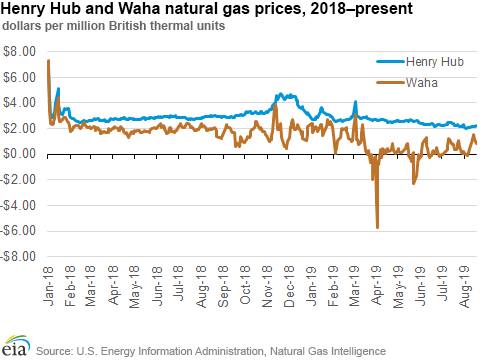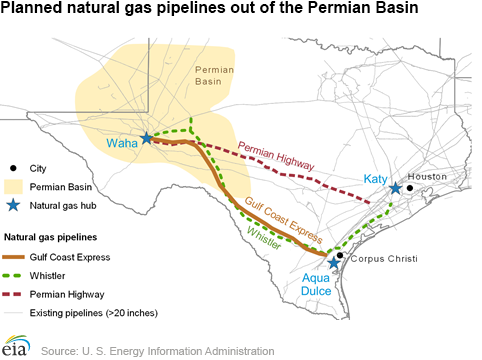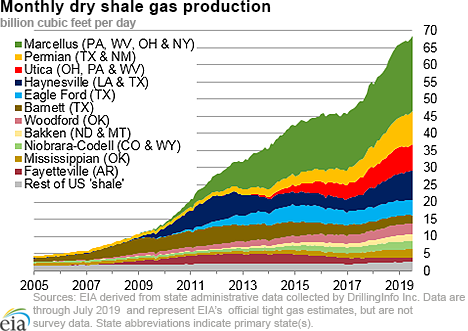In the News:
Permian Basin prices up in recent weeks as the Gulf Coast Express Pipeline nears completion
Natural gas spot prices at the Waha hub in western Texas, located near Permian Basin production activities, closed at $1.55/million British thermal units (MMBtu) on August 15, the highest price since March 2019. This price increase coincides with the 2 billion cubic feet per day (Bcf/d) Gulf Coast Express Pipeline (GCX) preparing to enter service. GCX will provide much-needed additional natural gas take-away pipeline capacity in the Permian region of western Texas and southeastern New Mexico.
Limited natural gas pipeline takeaway capacity in the region has kept prices very low or negative in recent months. In the first eight months of 2019 (through August 19), the Waha spot price averaged just 65¢/MMBtu. The Waha spot price has been consistently lower than the Henry Hub spot price, the national benchmark price for natural gas. However, in recent days, that differential has significantly decreased, with Waha spot prices closing 59¢/MMBtu lower than the Henry Hub spot price last Thursday, the lowest daily differential since mid-March. In comparison, this differential averaged between $2 and $3/MMBtu between March and June of this year.
This recent uptick in the Waha price coincides with flows on the GCX; deliveries into the pipeline began on August 8. S&P Global Platts reported that deliveries at El Paso Natural Gas Pipeline’s interconnection with GCX reached nearly 0.26 Bcf/d on August 14, an indication that GCX is packing its lines in anticipation of entering service late next month, according to industry reports, ahead of its announced in-service date of October 1. Once fully operational, the pipeline will be capable of sending about 2.0 Bcf/d of natural gas eastward to the Agua Dulce receipt point near the Texas Gulf Coast.
The Permian Basin in western Texas and southeastern New Mexico has seen large increases in natural gas production in recent years. Natural gas produced in the Permian Basin is largely associated natural gas, which is natural gas produced as a byproduct of crude oil production. Crude oil take-away capacity in the region expanded in early 2019. Producers in the region may vent or flare natural gas to a limited extent, but these activities are subject to regulation by the Texas Railroad Commission.
Overview:
(For the week ending Wednesday, August 21, 2019)
- Natural gas spot prices rose at most locations this report week (Wednesday, August 14 to Wednesday, August 21). Henry Hub spot prices rose from $2.15 per million British thermal units (MMBtu) last Wednesday to $2.25/MMBtu yesterday.
- At the New York Mercantile Exchange (Nymex), the price of the September 2019 contract increased 3¢, from $2.143/MMBtu last Wednesday to $2.170/MMBtu yesterday. The price of the 12-month strip averaging September 2019 through August 2020 futures contracts climbed 1¢/MMBtu to $2.329/MMBtu.
- Net injections to working gas totaled 59 billion cubic feet (Bcf) for the week ending August 16. Working natural gas stocks are 2,797 Bcf, which is 15% more than the year-ago level and 4% lower than the five-year (2014–18) average for this week.
- The natural gas plant liquids composite price at Mont Belvieu, Texas, fell by 23¢/MMBtu, averaging $4.10/MMBtu for the week ending August 21. The price of ethane, propane, butane, and isobutane fell by 2%, 5%, 11%, and 19%, respectively. The price of natural gasoline rose by 2%.
- According to Baker Hughes, for the week ending Tuesday, August 13, the natural gas rig count decreased by 4 to 165. The number of oil-directed rigs rose by 6 to 770. The total rig count increased by 1, and it now stands at 935.
Prices/Supply/Demand:
Prices rise with warmer weather. This report week (Wednesday, August 14 to Wednesday, August 21), Henry Hub spot prices rose 10¢ from $2.15/MMBtu last Wednesday to $2.25/MMBtu yesterday. Temperatures across the Lower 48 states were generally warmer than normal; they were much warmer than normal across most of Texas and a bit cooler than normal across the Great Plains.
Midwest prices rise slightly. At the Chicago Citygate, prices increased 8¢ from $2.00/MMBtu last Wednesday to $2.08/MMBtu yesterday. Kinder Morgan’s Natural Gas Pipeline Company of America (NGPL) declared a force majeure on Tuesday between Compressor Stations 104 and 105, stretching across most of Kansas, north of Wichita. Several other outages are in effect across the system, constraining downstream flows. According to Genscape, the restrictions will reduce flows by half (e.g., current operational capacity of 439 MMcf/d at Compressor Station 103 flowed an average of 906 MMcf/d in the 30 days before the incident).
California prices mixed. Prices at PG&E Citygate in Northern California rose 9¢, up from $2.57/MMBtu last Wednesday to $2.66/MMBtu yesterday. Prices at SoCal Citygate decreased 53¢ from a high of $3.18/MMBtu last Wednesday to $2.65/MMBtu yesterday.
Northeast prices rise. At the Algonquin Citygate, which serves Boston-area consumers, prices went up 10¢ from a low of $2.09/MMBtu last Wednesday to $2.19/MMBtu yesterday. At the Transcontinental Pipeline Zone 6 trading point for New York City, prices increased 13¢ from a low of $1.92/MMBtu last Wednesday to $2.05/MMBtu yesterday.
Tennessee Zone 4 Marcellus spot prices increased 4¢ from $1.68/MMBtu last Wednesday to $1.72/MMBtu yesterday. Prices at Dominion South in southwest Pennsylvania rose 1¢ from $1.79/MMBtu last Wednesday to $1.80/MMBtu yesterday.
Permian Basin prices decline throughout the week. Prices at the Waha Hub in West Texas, which is located near Permian Basin production activities, averaged $1.46/MMBtu last Wednesday, 69¢/MMBtu lower than Henry Hub prices. Prices reached a weekly high of $1.55/MMBtu on Thursday, the highest price since March 2019. Yesterday, prices at the Waha Hub averaged $0.97/MMBtu, $1.28/MMBtu lower than Henry Hub prices.
Amid high heat, the Electric Reliability Council of Texas (ERCOT)—the electric grid operator serving most of Texas—issued a request for conservation during one evening for the second week in a row. The request asked end-users to limit consumption during peak load through 7:00 p.m. that night. No power outages were reported.
Supply rises. According to data from PointLogic Energy, the average total supply of natural gas rose by 1% compared with the previous report week. Dry natural gas production remained constant week over week. Average net imports from Canada increased by 9% from last week, with increased demand in the Northeast. Flows into Upstate New York on the Iroquois Pipeline at Waddington averaged 0.42 Bcf/d for the report week, up from 0.15 Bcf/d the previous report week according to Genscape. Import volumes reached 0.75 Bcf on Monday, the highest daily volume since March 2019. In addition, Enbridge’s Westcoast pipeline increased deliverability on its system as of August 20, resulting in U.S. imports rising from 0.6 Bcf/d to 0.8 Bcf/d at Sumas, Washington.
Demand is flat. Total U.S. consumption of natural gas was unchanged from the previous report week, averaging 70.7 Bcf/d according to data from PointLogic Energy. Natural gas consumed for power generation declined by 1% week over week. Industrial sector consumption increased by 1% week over week. In the residential and commercial sectors, consumption increased by 2%. Natural gas exports to Mexico increased 1%.
U.S. LNG exports increase week over week. Nine liquefied natural gas (LNG) vessels (four from Sabine Pass, two each from Cove Point and Corpus Christi, and one from Cameron LNG terminals) with a combined LNG-carrying capacity of 32 Bcf departed the United States between August 15 and August 21, according to shipping data compiled by Bloomberg. One vessel was loading at the Sabine Pass and one at Corpus Christi terminals on Wednesday.
Scheduled maintenance at Sabine Pass LNG on Trains 3 and 4 was completed this week, several days ahead of a typical maintenance cycle at the facility, according to Genscape. Train 2 at Corpus Christi LNG terminal has also returned to full operation.
Train 1 at Cameron LNG terminal was placed in commercial operation this week. The facility exported its first LNG cargo in May and a total of six cargoes to-date.
Train 1 at Freeport LNG started LNG production on Monday, according to S&P Global Platts. Freeport LNG has become the sixth LNG export terminal in the United States. It expects to load the first cargo from Train 1 before the end of this month; the start of commercial operations is planned for September. An LNG tanker arrived to Freeport LNG terminal and is waiting to load first export cargo.
A fully approved Calcasieu Pass LNG export terminal in Louisiana made a final investment decision this week. The terminal will have a total 1.7 Bcf/d capacity across 10 trains.
Storage:
Net injections into storage totaled 59 Bcf for the week ending August 16, compared with the five-year (2014–18) average net injections of 51 Bcf and last year's net injections of 47 Bcf during the same week. Working gas stocks totaled 2,797 Bcf, which is 103 Bcf lower than the five-year average and 369 Bcf more than last year at this time.
According to The Desk survey of natural gas analysts, estimates of the weekly net change from working natural gas stocks ranged from net injections of 56 Bcf to 65 Bcf, with a median estimate of 61 Bcf.
The average rate of net injections into storage is 31% higher than the five-year average so far in the refill season (April through October). If the rate of injections into storage matched the five-year average of 10.4 Bcf/d for the remainder of the refill season, total inventories would be 3,589 Bcf on October 31, which is 103 Bcf lower than the five-year average of 3,692 Bcf for that time of year.
More storage data and analysis can be found on the Natural Gas Storage Dashboard and the Weekly Natural Gas Storage Report.
See also:
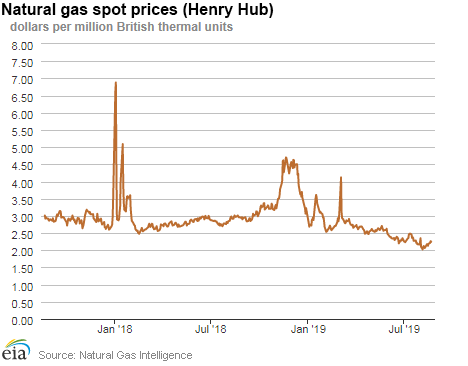
| Spot Prices ($/MMBtu) | Thu, 15-Aug |
Fri, 16-Aug |
Mon, 19-Aug |
Tue, 20-Aug |
Wed, 21-Aug |
|---|---|---|---|---|---|
| Henry Hub |
2.13 |
2.19 |
2.21 |
2.27 |
2.25 |
| New York |
1.96 |
2.05 |
2.27 |
2.15 |
2.05 |
| Chicago |
1.99 |
2.02 |
2.07 |
2.13 |
2.08 |
| Cal. Comp. Avg.* |
2.37 |
2.17 |
2.47 |
2.41 |
2.26 |
| Futures ($/MMBtu) | |||||
| September contract | 2.232 |
2.200 |
2.210 |
2.218 |
2.170 |
| October contract |
2.237 |
2.207 |
2.213 |
2.219 |
2.177 |
| *Avg. of NGI's reported prices for: Malin, PG&E Citygate, and Southern California Border Avg. | |||||
| Sources: Natural Gas Intelligence and CME Group as compiled by Bloomberg, L.P. | |||||
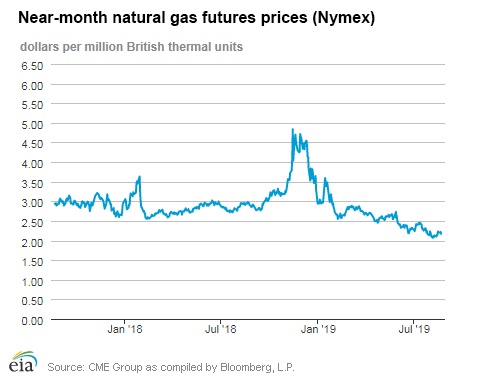
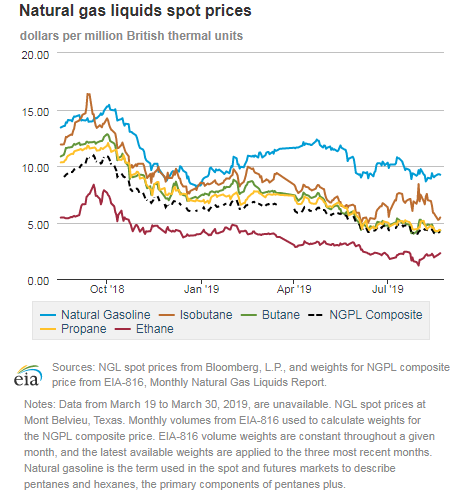
| U.S. natural gas supply - Gas Week: (8/15/19 - 8/21/19) | |||
|---|---|---|---|
Average daily values (Bcf/d): |
|||
this week |
last week |
last year |
|
| Marketed production | 103.1 |
102.6 |
95.8 |
| Dry production | 92.2 |
91.7 |
86.0 |
| Net Canada imports | 4.6 |
4.2 |
5.2 |
| LNG pipeline deliveries | 0.1 |
0.1 |
0.1 |
| Total supply | 96.9 |
96.0 |
91.3 |
|
Source: OPIS PointLogic Energy, an IHS Company | |||
| U.S. natural gas consumption - Gas Week: (8/15/19 - 8/21/19) | |||
|---|---|---|---|
Average daily values (Bcf/d): |
|||
this week |
last week |
last year |
|
| U.S. consumption | 70.7 |
70.9 |
67.5 |
| Power | 40.8 |
41.4 |
38.8 |
| Industrial | 21.2 |
20.9 |
20.4 |
| Residential/commercial | 8.7 |
8.5 |
8.4 |
| Mexico exports | 5.1 |
5.1 |
4.9 |
| Pipeline fuel use/losses | 6.5 |
6.5 |
6.1 |
| LNG pipeline receipts | 4.8 |
4.1 |
3.5 |
| Total demand | 87.1 |
86.5 |
81.9 |
|
Source: OPIS PointLogic Energy, an IHS Company | |||
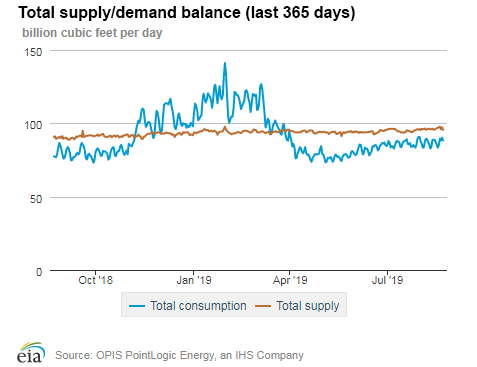
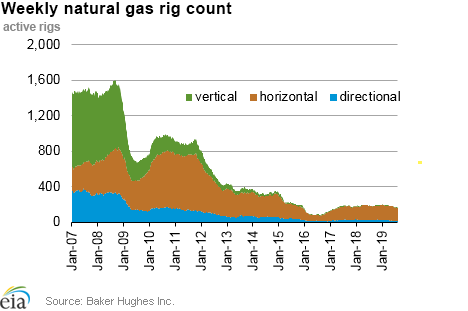
| Rigs | |||
|---|---|---|---|
Tue, August 13, 2019 |
Change from |
||
last week |
last year |
||
| Oil rigs | 770 |
0.8% |
-11.4% |
| Natural gas rigs | 165 |
-2.4% |
-11.3% |
| Note: Excludes any miscellaneous rigs | |||
| Rig numbers by type | |||
|---|---|---|---|
Tue, August 13, 2019 |
Change from |
||
last week |
last year |
||
| Vertical | 52 |
0.0% |
-20.0% |
| Horizontal | 815 |
-0.2% |
-11.6% |
| Directional | 68 |
4.6% |
-2.9% |
| Source: Baker Hughes Inc. | |||
| Working gas in underground storage | ||||
|---|---|---|---|---|
Stocks billion cubic feet (Bcf) |
||||
| Region | 2019-08-16 |
2019-08-09 |
change |
|
| East | 660 |
634 |
26 |
|
| Midwest | 760 |
729 |
31 |
|
| Mountain | 168 |
164 |
4 |
|
| Pacific | 274 |
272 |
2 |
|
| South Central | 935 |
939 |
-4 |
|
| Total | 2,797 |
2,738 |
59 |
|
|
Source: Form EIA-912, Weekly Underground Natural Gas Storage Report | ||||
| Working gas in underground storage | |||||
|---|---|---|---|---|---|
Historical comparisons |
|||||
Year ago (8/16/18) |
5-year average (2014-2018) |
||||
| Region | Stocks (Bcf) |
% change |
Stocks (Bcf) |
% change |
|
| East | 608 |
8.6 |
689 |
-4.2 |
|
| Midwest | 629 |
20.8 |
753 |
0.9 |
|
| Mountain | 153 |
9.8 |
182 |
-7.7 |
|
| Pacific | 238 |
15.1 |
295 |
-7.1 |
|
| South Central | 799 |
17.0 |
980 |
-4.6 |
|
| Total | 2,428 |
15.2 |
2,900 |
-3.6 |
|
| Source: Form EIA-912, Weekly Underground Natural Gas Storage Report | |||||
| Temperature – heating & cooling degree days (week ending Aug 15) | ||||||||
|---|---|---|---|---|---|---|---|---|
HDD deviation from: |
CDD deviation from: |
|||||||
| Region | HDD Current |
normal |
last year |
CDD Current |
normal |
last year |
||
| New England | 2 |
-2 |
1 |
34 |
-4 |
-24 |
||
| Middle Atlantic | 1 |
-2 |
1 |
48 |
-4 |
-19 |
||
| E N Central | 2 |
-3 |
2 |
47 |
-2 |
-16 |
||
| W N Central | 2 |
-1 |
2 |
61 |
-2 |
-11 |
||
| South Atlantic | 0 |
0 |
0 |
110 |
18 |
11 |
||
| E S Central | 0 |
0 |
0 |
109 |
20 |
17 |
||
| W S Central | 0 |
0 |
0 |
149 |
26 |
33 |
||
| Mountain | 1 |
-4 |
1 |
80 |
9 |
-2 |
||
| Pacific | 0 |
-2 |
0 |
53 |
8 |
-20 |
||
| United States | 1 |
-2 |
1 |
77 |
8 |
-4 |
||
|
Note: HDD = heating degree day; CDD = cooling degree day Source: National Oceanic and Atmospheric Administration | ||||||||
Average temperature (°F)
7-day mean ending Aug 15, 2019
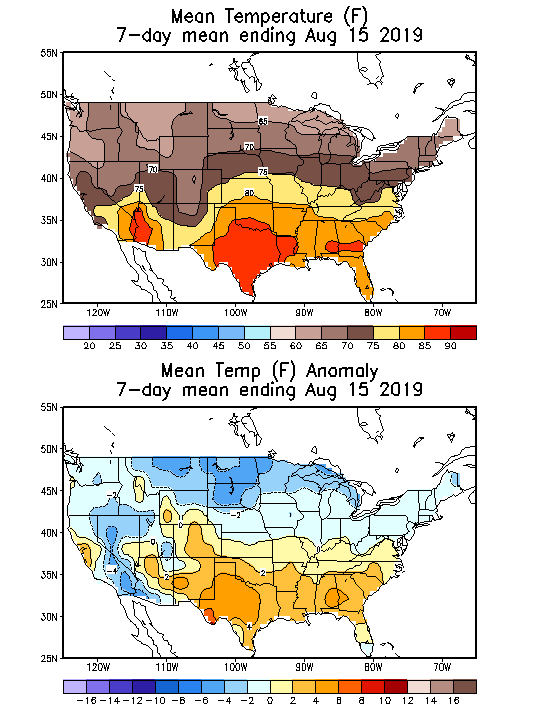
Source: National Oceanic and Atmospheric Administration
Deviation between average and normal (°F)
7-day mean ending Aug 15, 2019

Source: National Oceanic and Atmospheric Administration

